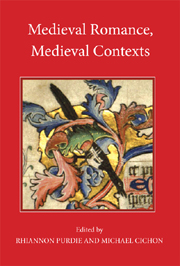Book contents
- Frontmatter
- Contents
- Acknowledgements
- Contributors
- Abbreviations
- Introduction: Romance and its Medieval Contexts
- 1 The Pleasure of Popular Romance: A Prefatory Essay
- 2 Representations of Peasant Speech: Some Literary and Social Contexts for The Taill of Rauf Coilyear
- 3 ‘As ye have brewd, so shal ye drink’: the Proverbial Context of Eger and Grime
- 4 Ekphrasis and Narrative in Emaré and Sir Eglamour of Artois
- 5 What's in a Name? Anglo-Norman Romances or Chansons de geste?
- 6 ‘For Goddes loue, sir, mercy!’: Recontextualising the Modern Critical Text of Floris and Blancheflor
- 7 Roland in England: Contextualising the Middle English Song of Roland
- 8 Romance Baptisms and Theological Contexts in The King of Tars and Sir Ferumbras
- 9 Modern and Medieval Views on Swooning: the Literary and Medical Contexts of Fainting in Romance
- 10 Walking (between) the Lines: Romance as Itinerary/Map
- 11 Romances of Continuity in the English Rous Roll
- 12 ‘Ex Libris domini duncani / Campbell de glenwrquhay/ miles’: The Buik of King Alexander the Conquerour in the household of Sir Duncan Campbell, seventh laird of Glenorchy
- 13 ‘Pur les francs homes amender’: Clerical Authors and the Thirteenth-Century Context of Historical Romance
- Index
- Volumes already published
1 - The Pleasure of Popular Romance: A Prefatory Essay
Published online by Cambridge University Press: 12 September 2012
- Frontmatter
- Contents
- Acknowledgements
- Contributors
- Abbreviations
- Introduction: Romance and its Medieval Contexts
- 1 The Pleasure of Popular Romance: A Prefatory Essay
- 2 Representations of Peasant Speech: Some Literary and Social Contexts for The Taill of Rauf Coilyear
- 3 ‘As ye have brewd, so shal ye drink’: the Proverbial Context of Eger and Grime
- 4 Ekphrasis and Narrative in Emaré and Sir Eglamour of Artois
- 5 What's in a Name? Anglo-Norman Romances or Chansons de geste?
- 6 ‘For Goddes loue, sir, mercy!’: Recontextualising the Modern Critical Text of Floris and Blancheflor
- 7 Roland in England: Contextualising the Middle English Song of Roland
- 8 Romance Baptisms and Theological Contexts in The King of Tars and Sir Ferumbras
- 9 Modern and Medieval Views on Swooning: the Literary and Medical Contexts of Fainting in Romance
- 10 Walking (between) the Lines: Romance as Itinerary/Map
- 11 Romances of Continuity in the English Rous Roll
- 12 ‘Ex Libris domini duncani / Campbell de glenwrquhay/ miles’: The Buik of King Alexander the Conquerour in the household of Sir Duncan Campbell, seventh laird of Glenorchy
- 13 ‘Pur les francs homes amender’: Clerical Authors and the Thirteenth-Century Context of Historical Romance
- Index
- Volumes already published
Summary
This piece aims to provide a particular context for the essays that follow by revisiting an essay on Middle English popular romances that I published nearly fifty years ago. It is an essay that has been frequently cited, though in a manner that is instructive of historical change. In early years, it was quoted with sometimes enthusiastic approval, but in recent years it has been increasingly singled out for criticism as an example of an outdated mode of approach. A recent scholar, writing on Havelok, is representative: she quotes one of the essay's many caustic criticisms of popular romance and says that it ‘typifies an early tradition of reading romance as hack-work written for a peasant or bourgeois audience’.
The ostensible point of the 1965 article was to provide a place for Middle English popular metrical romance in a formalist literary history, and to do so by concentrating on metre. The main body of Middle English metrical romance – the term ‘metrical’ being conventionally understood to exclude alliterative romance – was to be recognised, it was argued, as belonging to one of two significantly different metrical traditions, the one characterised by its use of the short octosyllabic couplet, the other by its use of tail-rhyme, in its various forms. The latter had been identified as a group and discussed at length by Trounce in a series of essays thirty years before, but his attempt to define a specifically East Anglian cultural milieu for tail-rhyme romance was flawed and his other arguments therefore subsequently neglected.
- Type
- Chapter
- Information
- Medieval Romance, Medieval Contexts , pp. 9 - 18Publisher: Boydell & BrewerPrint publication year: 2011



